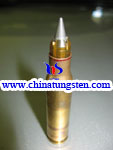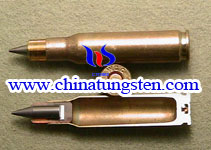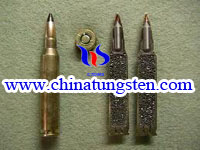Tungsten Alloy Armor Plating
A tungsten alloy plate that protects the lower part of a door from kicks and scratches, covering the door to a height usually 39 inches (l meter) or more. Heavy, flat steel, either surface-hardened or hardened throughout, used as a sheathing for warships, tanks, and so forth to resist penetration and deformation from heavy gunfire.

Rifle and pistol rounds are usually built around a penetrator of hardened steel or tungsten. Aircraft and tank rounds sometimes use a core of depleted uranium. The penetrator is a pointed mass of high-density material that is designed to retain its shape and carry the maximum possible amount of energy as deeply as possible into the target. Depleted-uranium penetrators have the advantage of being pyrophoric and self-sharpening on impact, resulting in intense heat and energy focused on a minimal area of the target's armor. Some rounds also use explosive or incendiary tips to aid in the penetration of thicker armor. High Explosive Incendiary/Armor Piercing Ammunition combines a tungsten alloy penetrator with an incendiary and explosive tip.
Here are some main advantages of tungsten alloy armor plating:
Tungsten Alloy Armor Plating Advantage 1 - High density up to 18.5 g/cm3
Tungsten Alloy Armor Plating Advantage 2 - Up to 65% denser than Lead
Tungsten Alloy Armor Plating Advantage 3 - Up to 130% denser than Steel
Tungsten Alloy Armor Plating Advantage 4 - Weakly Ferro magnetic
Tungsten Alloy Armor Plating Advantage 5 - Non-magnetic, if specifically required
Tungsten Alloy Armor Plating Advantage 6 - Non-Toxic alternative to Lead
Tungsten Alloy Armor Plating Advantage 7 - Corrosion resistant
Tungsten Alloy Armor Plating Advantage 8 - Easily machined
Tungsten alloy armor piercing shell must withstand the shock of punching through armor plating. Tungsten alloy armor plating designed for this purpose have a greatly strengthened case with an especially hardened and shaped nose, and a much smaller bursting charge. Some smaller-caliber AP shells have an inert filling, or incendiary charge in place of the HE bursting charge. The AP shell is now little used in naval warfare, as modern warships have little or no armor protection, but tungsten alloy armor piercing remains the preferred round in tank warfare, as it has a greater "first-hit kill" probability than a high explosive anti-tank (HEAT) round, especially against a target with composite armor, and because of higher muzzle velocity, is also more accurate than a HEAT round.Tungsten alloy armor plating cartridges are also available as small arms ammunition, primarily for use as an anti-materiel round.



Due to tungsten alloy armor plating special properties, tungsten alloy becomes a popular material in armor plating. So if you have any interest in tungsten alloy armor plating, please feel free to email us: [email protected], [email protected] or call us : 0086 592 512 9696, 0086 592 512 9595.
More Info>>
1.Cubes for Defence Military
2.Prefabricated Fragments
3.Scatter Grenades
4.Tungsten Penetrator






